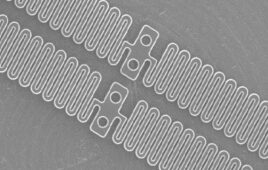 GW Plastics has something we’ve never seen. To be more accurate, the company has created something we can see through. GW Plastics has been molding optically clear silicone that is starting to gain interest for applications such as wearable technologies, endoscopes, optical sensors and instruments, medical lasers, diagnostics, light guides, light pipes, secondary optics, and other medical device-related applications.
GW Plastics has something we’ve never seen. To be more accurate, the company has created something we can see through. GW Plastics has been molding optically clear silicone that is starting to gain interest for applications such as wearable technologies, endoscopes, optical sensors and instruments, medical lasers, diagnostics, light guides, light pipes, secondary optics, and other medical device-related applications.
Still in its infancy within the medical device industry, optical silicone provides some intriguing opportunities. We asked GW Plastics expert Jason Bassi, Business Development Manager for the silicones division at GW Plastics, a few questions about this emerging technology.
Q: How did the idea of an optically clear LSR originate?
JB: The idea for optically clear silicone actually originated in the lighting industry where it is used within LED lighting applications. I first saw optical silicone being liquid injection molded 4 or 5 years ago, but it still seemed to be in its infancy. With GW Plastics’ core business being in the healthcare space, we tried to determine if there was interest within our current customer base. As we started exploring and becoming more familiar with molding the material, the opportunities began to present themselves. Although it is not clear if there is one application or niche that stands out for this material in the medical device market, we are seeing various applications that are prompting us to invest further in developing our capabilities and expertise.
 Q: What are some of the opportunities you seen in the marketplace?
Q: What are some of the opportunities you seen in the marketplace?
JB: The most common application we are seeing optical silicone being used for is to replace polycarbonate, PMMA, or glass in situations where the traditional optical materials are limiting the design or function of the device. In one instance, we are working to assist a customer in the development of a wearable device that needs to form to the body and direct light to specific areas. The detail in the lens is very intricate and needs to be exact to diffuse the light properly. This would not be possible with the traditional optical rigid materials.
We are also seeing applications that involve UV light transmission that have a negative effect over time on polycarbonate and PMMA. Because optical silicone has excellent UV light resistance, it becomes a better long-term choice. Overall, we have noticed a similar pattern developing for the use of optical silicone in the medical device market as we have seen with liquid injection molding in general. Our customers face challenges that require an optical surface but are limited with the traditional materials. Most of the applications center on creating highly precise features or geometries that are difficult to fabricate with current methods and materials. The low viscosity before cure makes molding optical silicone into complex shapes easier than with either organic polymers or glass.
Q: What are the attributes that make the silicone most interesting?
JB: The programs we have been most successful with have not necessarily started with the intention of utilizing optical silicone. Often we are getting involved because a customer has a challenge that they feel silicone can solve. The benefits of silicone include being bacterial resistant, UV resistant, biocompatible, low viscosity for molding precise and difficult features, temperature flexibility from -180F to 600F, chemical resistance, and fatigue and compression set resistance, and it initially meets a need beyond the optical properties of the silicone. The true benefit is the design flexibility, along with the great physical properties of the material. Because the optical grade silicones additionally have excellent optical clarity, light dissipation properties, and durability, the results have been very encouraging.
Q: What are some design considerations that OEMs should take into account when working with the material?
JB: I think design freedom and flexibility is the key here. Because of the low viscosity of the optical silicone and liquid silicone rubber in general, liquid injection molding of optical silicone allows for the molding of geometries that would not otherwise be possible with other organic polymers and glass. Thin walls, the reduced likelihood of sink allowing for thicker walls, precise features, varying wall thicknesses, small undercuts, negative draft, and difficult parts to fill can all be achieved with optical silicone. Other areas that should be considered are combining multiple components into one molded component. We see this in cases where a lens is combined with a seal. By molding the lens with an optical grade silicone, the seal can be incorporated into the lens reducing a component and an assembly step.
I think we are just starting to see some of the areas optical silicone can be of value in the healthcare market. The one limitation I do see at this point is that there are no medical grade optical silicones that I am aware of. I don’t feel this is as much of a technical hurdle as it is a business decision. Once the demand surfaces, I think the material suppliers will take the next steps to provide what the market drives.




